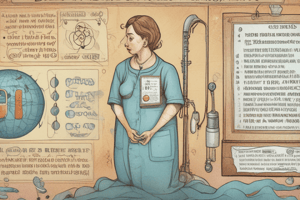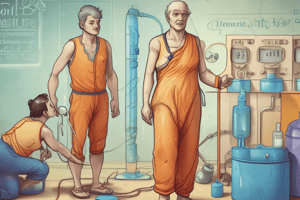Podcast
Questions and Answers
What is the fasting glucose level that indicates diabetes mellitus (DM)?
What is the fasting glucose level that indicates diabetes mellitus (DM)?
- 140
- 110
- 126 (correct)
- 100
An A1c level of 5.6 is considered pre-diabetes.
An A1c level of 5.6 is considered pre-diabetes.
False (B)
What medication should always be first-line for diabetes treatment?
What medication should always be first-line for diabetes treatment?
Metformin
Insulin dosing must be coordinated with ______ intake in DM1.
Insulin dosing must be coordinated with ______ intake in DM1.
Which type of insulin is known to control postprandial rise in blood glucose?
Which type of insulin is known to control postprandial rise in blood glucose?
Thiazide or calcium channel blockers (CCB) cannot be used in diabetic patients with hypertension.
Thiazide or calcium channel blockers (CCB) cannot be used in diabetic patients with hypertension.
What is the initial recommended A1c target for adjusting insulin dosage?
What is the initial recommended A1c target for adjusting insulin dosage?
The 'Rule of 15' suggests consuming ______ grams of sugar to address hypoglycemia.
The 'Rule of 15' suggests consuming ______ grams of sugar to address hypoglycemia.
What should be monitored every three months in diabetic patients?
What should be monitored every three months in diabetic patients?
Match the following insulin types with their characteristics:
Match the following insulin types with their characteristics:
Flashcards are hidden until you start studying
Study Notes
Diagnostic Criteria and Pre-DM
- Fasting glucose ≥ 126, random glucose ≥ 200, or symptoms of DM with A1c ≥ 6.5
- Pre-DM: A1c 5.7-6.4, requires lifestyle modification
Insulin Therapy
- Individualized therapy based on hypoglycemia symptoms, liver/renal distinction, price, A1c lowering ability, and prescribing experience
- Insulin dosing must be coordinated with carbohydrate intake in DM1
- Increase in carbs requires increase in insulin, while missed meal/low carbs requires decrease in insulin
DM with HTN
- ACE or ARB (first choice) can reduce the risk of DM nephropathy
- Thiazide or CCB can also be used
Insulin Types
- Short-acting:
- Lispro (Humalog): controls postprandial rise in blood glucose
- Aspart (Novolog)
- Glulisine (Apidra)
- Regular: slowest of short-acting, can be given IV and inhaled Afrezza
- Intermediate/Long-acting:
- NPH (Humulin N, Novolin N): provides glycemic control between meals and at bedtime, suitable for mixing with short-acting insulins
- Detemir (Levemir): long-acting
- Glargine (Lantus): long-acting, 100 and 300 units available
Hypoglycemia Management
- Conscious patient: use orange juice, ½ can of REAL soda, or glucose tabs
- Rule of 15: 15g of sugar and test in 15 minutes, repeat until blood glucose increases
- After increase, eat fat/protein snack or meal
- Glucose-centric algorithm for glycemic control: refer to sheet
Metformin and Insulin Algorithm
- Metformin should always be first, incorporate lifestyle, and recheck A1c every three months
- Algorithm for adding/intensifying insulin: basal insulin (long-acting), then prandial insulin if not controlled
- A1c ≥ 8%: TDD 0.2-0.3 U/kg, titrate every 2-5 days until under control
Oral Meds for DM2
- Sulfonylureas: stimulate pancreas, hypoglycemia risk, weight gain, and renal toxicity
- Other classes of oral meds for DM2: refer to table
Studying That Suits You
Use AI to generate personalized quizzes and flashcards to suit your learning preferences.




